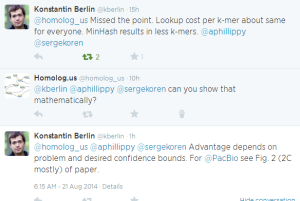
An Algorithmic Comparison of BLASR/BWA-MEM, DALIGN and MHAP
The problem of assembling a large number of noisy long reads is expected to show up, no matter whether one uses Pacbio or nanopore long read technology. The good news is that it is possible to do the assembly and the quality is a lot better than what can be achieved with short reads or even Sanger reads at far higher cost. The latest MHAP paper has excellent demonstration of this point regarding the Drosophila genome.
With that knowledge, let us look at the biggest informatics challenge at hand and that is how to align many read pairs against each other. To visualize the scale of the problem, if one plans to assemble human genome from 5kB reads with 50x coverage, that means he will have to work with about 30 million reads. Aligning those 30 million reads all against all is the most time- consuming step in the assembly. That means 30 million x 30 million = 900 trillion alignments of very noisy reads, where Smith-Waterman is the most viable approach.
How to do 900 trillion alignments of long read pairs? The answer is simple - don’t do it, and that is where the main innovation of BLASR/BWAMEM, DALIGN and MHAP come in. All three methods pick only a subset of read pairs to do the actual alignment, and that subset is selected based on sharing of unusually large number of k-mers between read pairs. The difference between the algorithms is in how they find those shared k-mers. To compare the time- performances of the algorithms, one needs to understand both mathematical aspects of the respective methods and the hardware-related issues, because a large amount of data are being swapped between hard-disk, memory and processor during the course of execution.
DALIGN
Gene Myers’ DALIGN uses the most straightforward method. It takes a subset of reads, finds all kmers along with their locations, sorts them and identifies matching pairs. Sorting is the most time-consuming step here, and Myers uses the speed difference between L1 cache and RAM to build a clever sorting algorithm that keeps data within the L1 cache. That can give one 100x boost in access time over RAM, and moreover the conflict between processors is not an issue, because each processor has its own L1 cache.
BLASR/BWA-MEM
BLASR and BWA-MEM use Burrows Wheeler transform and FM index of the collection of reads and then finds shared kmers by doing BWT-based perfect match alignment.
There are three difficulties here compared to DALIGN.
(i) Unlike human genome, where the reference is fixed, the BWT of reads have to be constructed again and again for every read library and that adds to the cost of alignment.
(ii) BWT-based FM index is saved in the RAM and it randomizes the locations compared to the genomic locations. Therefore, the RAM access is effectively random and slows down the process.
(iii) If one has many processors aligning many reads in parallel, memory bandwidth becomes the major bottleneck, because each processor wants to align its own segment with the index in the RAM.
MHAP
MHAP creates a hash table of kmers in a read and attempts to find other matching ones based on the number of hash collisions. I think that is essentially what their algorithm boils down to after you remove all bells and whistles about MinHash sketch. If my interpretation is correct, maybe one can even get rid of the MinHash sketch and simply use a one- dimensional hash.
Here is the problem. The number of comparisons in their approach will scale as N^2, whereas the scaling will be closer to N or N.log(N) for other two approaches (ignoring the insignificant cost of BWT construction for BWAMEM and BLASR). [Edit. the claim about N^2 is wrong, as Adam points out in the supplement.]
Am I missing something here?
-———————-
Edit.
1. The author of MHAP responds:

2. I asked Gene Myers about this post, and he mentioned that there is a third component (‘verifier’) after ‘kmer filtering’ and ‘alignment’ that my blog post did not mention. He also pointed out that verifier takes the most time among all, and should be subject to algorithm development and optimization. Here is his full email -
One thing that isn’t correct though it that the majority of the time taken by DALIGN and all of these tools, is for computing and verifying an alignment between two reads once a pair of reads has been identified as possibly matching. That is, the computation is divided into a “filter” that as efficiently as possible identifies pairs of reads that might have a local/overlap alignment, followed by a “verifier” that determines if the pair actually share a local alignment and delivers the alignment.
The verify takes 80%-90% of the time for DALIGN. MHAP and BLASR both spend a lot of effort focused on making the filter fast, which is not the main issue because most of the time is in the verifier. You do not describe the verifiers for the three methods and that is the important part of the problem ! Also the authors of MHAP and BLASR also don’t seem to understand that this is where the optimization effort should be going.